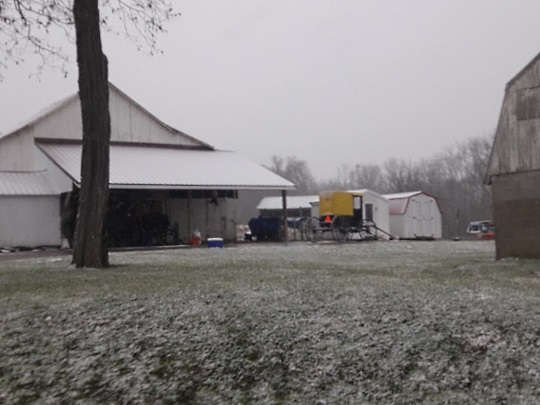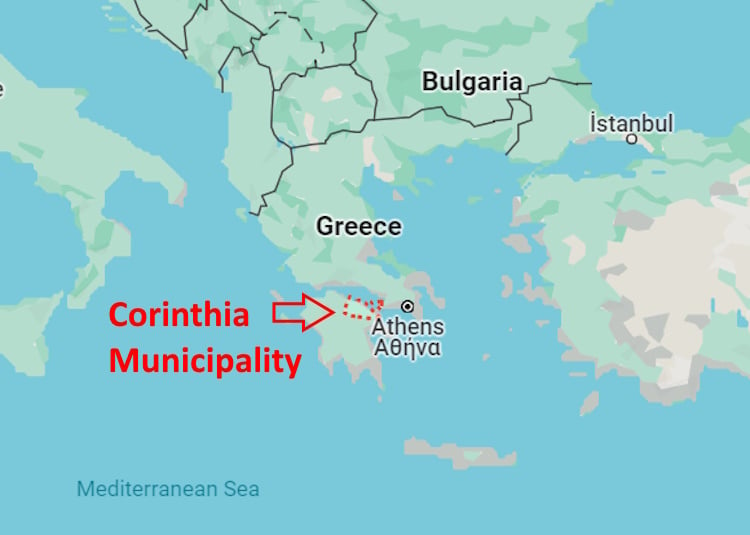How will the East Palestine chemical spill affect the Amish?
This is maybe the most commonly-asked question I’ve gotten in the weeks following the February 3 train derailment and chemical spill and burn in East Palestine, Ohio. This is is an area right on the border with Pennsylvania. There are a number of Amish communities in the region. Within the greater overall concern for the residents of the region, a number of people have been wondering specifically about the area’s Amish residents.
So right up front: I don’t have a lot of info to add here. I (mostly) haven’t been in touch with anyone from that area on the spill (just one person, but the comments were off the record). So I cannot share anything on the “Amish attitude” towards this happening, or ways in which they may have altered their behavior as a result.

But, I can at least tell you which Amish communities are near to East Palestine to give a sense of how many Amish might be affected. And throw in my two cents’ worth.
How many Amish live near the spill – and where?
East Palestine is located in Columbiana County. I have been through this area once or twice in the past but am not really familiar with it. I can tell you the county has three Amish communities lying within its borders (all info below via “Amish Population in the United States by State, County, and Settlement, 2022“.
- Rogers – this Amish community lies roughly seven miles from the spill. There are about 175 Amish living here.
- Wellsville – This looks to be the furthest community within the county from the spill, at around 20 miles away. Around 75 Amish call this community home.
- “Unity Valley” – so this one is difficult to find on the map. Sometimes communities are known by nicknames. Nothing comes up in Google Maps by that exact name for this area. However, there is an area named Unity quite nearby, and a Unity Township. So that could very well be the location. If so, this would be the closest Amish community to the spill, just a couple-few miles north of the town. This settlement has about 145 Amish residents.
Additionally, the community at Enon Valley lies just over the border in Pennsylvania, about 5 miles from East Palestine. From what I recall, the Amish live north of the village itself (if someone knows better, feel free to correct me). As you can see on the map below the derailment occurred on the east side of town, nearly over the border into PA.

The Amish of Enon Valley are mentioned in this article on the spill, though only briefly. It is s small community – only one church district and maybe a dozen and a half households (around 90 people). I visited this settlement several years ago and detailed that visit here.

Further north from Enon Valley is the New Wilmington Amish community, at around 25 miles away. Close to 3,000 Amish live there. Beyond that, there are quite a few Amish further north in Mercer County, but further out.
That is pretty much the extent of what I have found within about a 30-mile radius from the spill and burn site.
I mention 30 miles because one of the several class action lawsuits that have been filed against Norfolk Southern Railways seeks payment for medical testing and treatment for people within 30 miles of the spill. So by my tally above, there are five Amish communities and roughly 3,500 Amish residents within that radius.
How has the chemical spill affected Amish?
I think people are showing special concern for area Amish both because of their affinity for and friendships with Amish, and also since the Amish are known as a farming people, and the spill is expected to have significant environmental impact.
Will Amish move away as a result? I do not know. Will they change their behavior in some way? (stop farming?) If I had to guess, I am skeptical that they are doing much differently. The spill got a huge amount of attention and there is a lot of understandable concern over the health and environmental impact. Large numbers of fish have apparently died, and people have complained of health ailments and chemical smells, though it’s apparently unclear whether the chemical release has actually caused sickness among people.
At the same time there are a lot of unknowns as to the long-term effects of the incident. Things which might not play out for years or decades, which are difficult to predict. As one expert described it:
One issue with toxic chemical releases is that the hazards are posed not just by the individual chemicals involved, said Gerald Poje, an expert in environmental health and former member of the U.S. Chemical Safety and Hazard Investigation Board. Chemical compounds can interact with one another in complex ways and persist after burning.
“There could be hundreds of different breakdown products that still remain, for which we have often very poor toxicological profiles,” Dr. Poje said. “We’re oftentimes in this unknown place.”
That all sounds bad, or at least scary, in that it’s unknown. However, in the absence of immediately-seen effects, inertia tends to keep people in place. So I wouldn’t expect a big exodus of Amish people from the communities I’ve detailed above.
Like I said at the beginning, I’m not plugged in to the pulse of the local Amish in this region. But I’d be curious about your insights and any additional information you might have – both in general, or from Amish or Amish-adjacent sources.








in General
There was a derailment in 1982 Livingston Louisiana they are saying there are similar with chemicals and what happen in the aftermath. So if anyone is interested look up 1982 derailment Livingston Louisiana and you will get a general idea of what East palestine Ohio will be going through.
TMI
Look up the Three Mile Island nuclear accident back in the 1970’s and find out if the Amish left Lancaster County, Pa. A few that lived adjoining. The rest (and all of us other Plain People) ignored it.
If it affects obvious health now, some may move. If it is out of sight, it will likely be out of mind. At least after the next event – mud sale or horse auction or ???
Yes, I think this is normal for humans in general, and with the average Amish or Plain person not having near the same media exposure, this may end up more out of sight out of mind for them than their fellow non-Amish residents in the area.
Livestock will show the effects
Maybe you will hear from the community whether their animals and poultry are affected. I would anticipate loss. I am so sorry for anything near that area, helpless around that poison. Please do keep updating on it!
Would the Amish accept financial reimbursement for any harm?
Erik,
Yes, certainly, a lot of unknowns here.
My brain tends to jump ahead, which doesn’t help solve this environmental challenge.
I wonder, at what point would the Amish accept governmental or railroad assistance if there was proven harm to their health or income? Another question, Will the Amish participate in any long-term health studies? We’ll see.
Thanks for your post, Jim
Both good questions Jim, and with the usual caveats about how things vary by group, I’d say I think they’d be more open to the idea of joining in health studies than they would accepting government assistance.
Though there have been some cases of Amish accepting say unemployment benefits, generally it’s uncommon. On the other hand, they’ve willingly participated in a number of health studies, two that come right to mind are on the effects of second-hand smoke, and on the “longevity” gene in one Indiana community.
May not be able to move
I watched a news clip about the spill which showed a nasty oily substance rising through creek water when the creek bed was disturbed. The news anchor asked “Would you drink this? Would you move away?” My immediate thought was—how many people can actually afford to move away? Many people, myself included, need to sell before moving. People who rent might be able to leave quickly provided they can find employment elsewhere, but those who own properties,on what might have even been valuable land, will probably find it quite difficult to find a buyer. The question may not be “would you move away?” but “would you buy here?” Many property owners will likely have to stay whether they want to or not.
Yes, very good point. When these types of misfortunes happen, it’s not like moving away means getting out scot-free, especially as a property owner. You’re going to take a loss if you even manage to sell.
Tragedy
This tragedy will be played out for decades to come.
My heritage is in the Hocking Hills. I grew up in Columbus, & my 54 yr old niece, through no fault of her own, suffers from a TBI & is disabled. Her fiancé’s elderly mother lives with them. She & her fiancé moved to McConnelsville, on the Ohio River 3 yrs ago, escaping a violent suburb of Columbus, hoping to have peace of mind on a 30 acre orchard & tiny cabin. It is spring fed from the Ohio. All rivers, springs, tributaries & wells are fed by the Ohio. Thankfully there children are grown & out of state.
This will be the story, dilemma & heartbreak for thousands & thousands that are dependent on the Ohio River. Moving is near impossible for Eastern Ohio & Kentucky & PA. Considered the Appalachians…already the poorest of the poor in our country.
I pray for everyone, especially young parents, who just don’t have a pot or window to throw it out of (old AHIA saying). My grandfather & great grandfather worked for the Pennsylvania Railroad, making this even more ironic. All those wonderful salt of the earth people are weighing heavily on my mind.
Prayers
Prayers for everyone involved. I actually lived in Graniteville, South Carolina during the Graniteville train disaster. Two trains crashed into each other, and there was a chlorine gas spill. Nine people died. A lot of us who survived have permanent health problems. And I have had to deal with Norfolk Southern and the federal government, and, I don’t trust either. My advice to everyone involved: have a lawyer read anything either one wants you to sign. I was a minor during the Graniteville train disaster (teenager), but, I still had to read a lot, and was still expected to sign, a lot (even though, as a minor, my mother had pretty much all veto power). I have a friend whose family lives in the area, and I am seriously concerned for them.